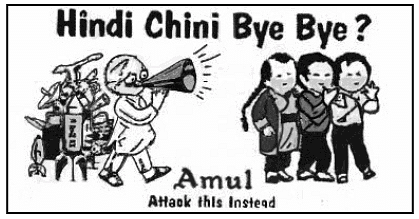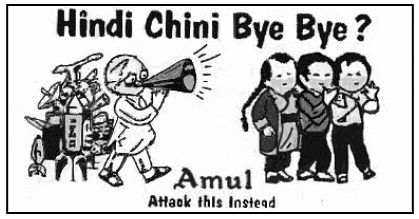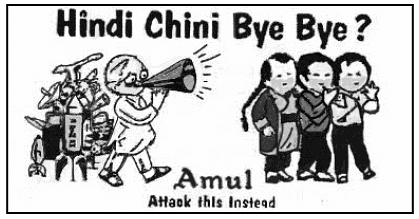Test: India’s External Relations- Case based Type Questions - Humanities/Arts MCQ
16 Questions MCQ Test Political Science Class 12 - Test: India’s External Relations- Case based Type Questions
Study the picture below and answer the questions that follow:

Q. Which year does the event happen?

Study the picture below and answer the questions that follow:

Q. Which two countries' relationships were strained after Suppression of Tibetan culture?

| 1 Crore+ students have signed up on EduRev. Have you? Download the App |
Study the picture below and answer the questions that follow:

Q. What message does this cartoon convey?

Study the picture below and answer the questions that follow:

Q. Which event does this cartoon depict?
Answer the following questions by reading the given paragraph:
The first Prime Minister, Jawahar Lal Nehru played a crucial role in setting the national agenda. He was his own Foreign Minister. Thus, both as the Prime Minister and the Foreign Minister, he exercised profound influence in the formulation and implementation of India’s foreign policy from 1946 to 1964. The three major objectives of Nehru’s foreign policy were to preserve the hardearned sovereignty, protect territorial integrity, and promote rapid economic development. Nehru wished to achieve these objectives through the strategy of non-alignment. There were, of course, parties and groups in the country that believed that India should be friendlier with the bloc led by the US because that bloc claimed to be pro-democracy. Among those who thought on these lines were leaders like Dr. Ambedkar. Some political parties, which were opposed to communism, also wanted India to follow a pro-US foreign policy. These included the Bharatiya Jan Sangh and later the Swatantra Party. But Nehru possessed considerable leeway in formulating foreign policy.
Q. What were the three major objectives of Nehru’s foreign policy?
Answer the following questions by reading the given paragraph:
The first Prime Minister, Jawahar Lal Nehru played a crucial role in setting the national agenda. He was his own Foreign Minister. Thus, both as the Prime Minister and the Foreign Minister, he exercised profound influence in the formulation and implementation of India’s foreign policy from 1946 to 1964. The three major objectives of Nehru’s foreign policy were to preserve the hardearned sovereignty, protect territorial integrity, and promote rapid economic development. Nehru wished to achieve these objectives through the strategy of non-alignment. There were, of course, parties and groups in the country that believed that India should be friendlier with the bloc led by the US because that bloc claimed to be pro-democracy. Among those who thought on these lines were leaders like Dr. Ambedkar. Some political parties, which were opposed to communism, also wanted India to follow a pro-US foreign policy. These included the Bharatiya Jan Sangh and later the Swatantra Party. But Nehru possessed considerable leeway in formulating foreign policy.
Q. What was the nature of the policy of US bloc?
Answer the following questions by reading the given paragraph:
The first Prime Minister, Jawahar Lal Nehru played a crucial role in setting the national agenda. He was his own Foreign Minister. Thus, both as the Prime Minister and the Foreign Minister, he exercised profound influence in the formulation and implementation of India’s foreign policy from 1946 to 1964. The three major objectives of Nehru’s foreign policy were to preserve the hardearned sovereignty, protect territorial integrity, and promote rapid economic development. Nehru wished to achieve these objectives through the strategy of non-alignment. There were, of course, parties and groups in the country that believed that India should be friendlier with the bloc led by the US because that bloc claimed to be pro-democracy. Among those who thought on these lines were leaders like Dr. Ambedkar. Some political parties, which were opposed to communism, also wanted India to follow a pro-US foreign policy. These included the Bharatiya Jan Sangh and later the Swatantra Party. But Nehru possessed considerable leeway in formulating foreign policy.
Q. Who was the foreign minister during the time of Pt. Nehru?
Answer the following questions by reading the given paragraph:
The first Prime Minister, Jawahar Lal Nehru played a crucial role in setting the national agenda. He was his own Foreign Minister. Thus, both as the Prime Minister and the Foreign Minister, he exercised profound influence in the formulation and implementation of India’s foreign policy from 1946 to 1964. The three major objectives of Nehru’s foreign policy were to preserve the hardearned sovereignty, protect territorial integrity, and promote rapid economic development. Nehru wished to achieve these objectives through the strategy of non-alignment. There were, of course, parties and groups in the country that believed that India should be friendlier with the bloc led by the US because that bloc claimed to be pro-democracy. Among those who thought on these lines were leaders like Dr. Ambedkar. Some political parties, which were opposed to communism, also wanted India to follow a pro-US foreign policy. These included the Bharatiya Jan Sangh and later the Swatantra Party. But Nehru possessed considerable leeway in formulating foreign policy.
Q. Which of the following leaders were in favour of supporting the US bloc?
Read the following paragraph and answer the questions that follow:
India has opposed the international treaties aimed at non-proliferation since they were selectively applicable to the non-nuclear powers and legitimised the monopoly of the five nuclear weapons powers. Thus, India opposed the indefinite extension of the NPT in 1995 and also refused to sign the Comprehensive Test Ban Treaty (CTBT). India conducted a series of nuclear tests in May 1998, demonstrating its capacity to use nuclear energy for military purposes. Pakistan soon followed, thereby increasing the vulnerability of the region to a nuclear exchange. The international community was extremely critical of the nuclear tests in the subcontinent and sanctions were imposed on both India and Pakistan, which were subsequently waived. India’s nuclear doctrine of credible minimum nuclear deterrence professes “no first use” and reiterates India’s commitment to global, verifiable and non-discriminatory nuclear disarmament leading to a nuclear weapons free world. Foreign policy is always dictated by ideas of national interest. In the period after 1990, Russia, though it continues to be an important friend of India, has lost its global pre-eminence. Therefore, India’s foreign policy has shifted to a more pro-US strategy.
Q. When did India conduct series of nuclear tests?
Read the following paragraph and answer the questions that follow:
India has opposed the international treaties aimed at non-proliferation since they were selectively applicable to the non-nuclear powers and legitimised the monopoly of the five nuclear weapons powers. Thus, India opposed the indefinite extension of the NPT in 1995 and also refused to sign the Comprehensive Test Ban Treaty (CTBT). India conducted a series of nuclear tests in May 1998, demonstrating its capacity to use nuclear energy for military purposes. Pakistan soon followed, thereby increasing the vulnerability of the region to a nuclear exchange. The international community was extremely critical of the nuclear tests in the subcontinent and sanctions were imposed on both India and Pakistan, which were subsequently waived. India’s nuclear doctrine of credible minimum nuclear deterrence professes “no first use” and reiterates India’s commitment to global, verifiable and non-discriminatory nuclear disarmament leading to a nuclear weapons free world. Foreign policy is always dictated by ideas of national interest. In the period after 1990, Russia, though it continues to be an important friend of India, has lost its global pre-eminence. Therefore, India’s foreign policy has shifted to a more pro-US strategy.
Q. Which one of the following is India’s stand for the use of nuclear weapon?
Read the following paragraph and answer the questions that follow:
India has opposed the international treaties aimed at non-proliferation since they were selectively applicable to the non-nuclear powers and legitimised the monopoly of the five nuclear weapons powers. Thus, India opposed the indefinite extension of the NPT in 1995 and also refused to sign the Comprehensive Test Ban Treaty (CTBT). India conducted a series of nuclear tests in May 1998, demonstrating its capacity to use nuclear energy for military purposes. Pakistan soon followed, thereby increasing the vulnerability of the region to a nuclear exchange. The international community was extremely critical of the nuclear tests in the subcontinent and sanctions were imposed on both India and Pakistan, which were subsequently waived. India’s nuclear doctrine of credible minimum nuclear deterrence professes “no first use” and reiterates India’s commitment to global, verifiable and non-discriminatory nuclear disarmament leading to a nuclear weapons free world. Foreign policy is always dictated by ideas of national interest. In the period after 1990, Russia, though it continues to be an important friend of India, has lost its global pre-eminence. Therefore, India’s foreign policy has shifted to a more pro-US strategy.
Q. Which of the following nuclear treaties were rejected by India?
Read the following paragraph and answer the questions that follow:
India has opposed the international treaties aimed at non-proliferation since they were selectively applicable to the non-nuclear powers and legitimised the monopoly of the five nuclear weapons powers. Thus, India opposed the indefinite extension of the NPT in 1995 and also refused to sign the Comprehensive Test Ban Treaty (CTBT). India conducted a series of nuclear tests in May 1998, demonstrating its capacity to use nuclear energy for military purposes. Pakistan soon followed, thereby increasing the vulnerability of the region to a nuclear exchange. The international community was extremely critical of the nuclear tests in the subcontinent and sanctions were imposed on both India and Pakistan, which were subsequently waived. India’s nuclear doctrine of credible minimum nuclear deterrence professes “no first use” and reiterates India’s commitment to global, verifiable and non-discriminatory nuclear disarmament leading to a nuclear weapons free world. Foreign policy is always dictated by ideas of national interest. In the period after 1990, Russia, though it continues to be an important friend of India, has lost its global pre-eminence. Therefore, India’s foreign policy has shifted to a more pro-US strategy.
Q. Why India’s foreign policy shifted to become more pro-US?
Read the given paragraph and answer the questions that follow:
On April 8th, 2008 The Hindu published an article titled “Potential consequences of a regional nuclear conflict” in which the author convincingly illustrates the dangers a nuclear- armed South Asia presents. The fact that both India and Pakistan, but of course also China, possess nuclear weapons has been an alarming reality since 1998. The relative progress that has been achieved in India- Pakistan relations should not lead one to forget that two conflicts in 1999 and 2001 could easily have escalated into a nuclear confrontation.
India had embarked upon a civilian nuclear program right after her independence but the “weapon option” has always been present. India’s nuclear policy has been an evolutionary, sometimes painful process equally shaped by domestic and international factors. This paper attempts to analyse some of these factors and argues that the development of nuclear weapons was a logical, albeit not planned, consequence of them. It is interesting that even those in India fiercely opposed to nuclear weapons subconsciously seemed to have realised that India’s nuclear program could not be limited to civilian application forever. On May 27th, 1998, the government of the then- prime minister Atal Bihari Vajpayee issued a statement to the 12th Lok Sabha titled the “Evolution of India’s Nuclear Policy”.
Q. Which of the two conflicts between India and Pakistan could have led to a nuclear war?
Read the given paragraph and answer the questions that follow:
On April 8th, 2008 The Hindu published an article titled “Potential consequences of a regional nuclear conflict” in which the author convincingly illustrates the dangers a nuclear- armed South Asia presents. The fact that both India and Pakistan, but of course also China, possess nuclear weapons has been an alarming reality since 1998. The relative progress that has been achieved in India- Pakistan relations should not lead one to forget that two conflicts in 1999 and 2001 could easily have escalated into a nuclear confrontation.
India had embarked upon a civilian nuclear program right after her independence but the “weapon option” has always been present. India’s nuclear policy has been an evolutionary, sometimes painful process equally shaped by domestic and international factors. This paper attempts to analyse some of these factors and argues that the development of nuclear weapons was a logical, albeit not planned, consequence of them. It is interesting that even those in India fiercely opposed to nuclear weapons subconsciously seemed to have realised that India’s nuclear program could not be limited to civilian application forever. On May 27th, 1998, the government of the then- prime minister Atal Bihari Vajpayee issued a statement to the 12th Lok Sabha titled the “Evolution of India’s Nuclear Policy”.
Q. Who issued the statement in 12th Lok Sabha for “Evolution of India’s nuclear policy”?
Read the given paragraph and answer the questions that follow:
On April 8th, 2008 The Hindu published an article titled “Potential consequences of a regional nuclear conflict” in which the author convincingly illustrates the dangers a nuclear- armed South Asia presents. The fact that both India and Pakistan, but of course also China, possess nuclear weapons has been an alarming reality since 1998. The relative progress that has been achieved in India- Pakistan relations should not lead one to forget that two conflicts in 1999 and 2001 could easily have escalated into a nuclear confrontation.
India had embarked upon a civilian nuclear program right after her independence but the “weapon option” has always been present. India’s nuclear policy has been an evolutionary, sometimes painful process equally shaped by domestic and international factors. This paper attempts to analyse some of these factors and argues that the development of nuclear weapons was a logical, albeit not planned, consequence of them. It is interesting that even those in India fiercely opposed to nuclear weapons subconsciously seemed to have realised that India’s nuclear program could not be limited to civilian application forever. On May 27th, 1998, the government of the then- prime minister Atal Bihari Vajpayee issued a statement to the 12th Lok Sabha titled the “Evolution of India’s Nuclear Policy”.
Q. Which newspaper published the article titled “Potential consequences of a regional nuclear conflict”?
Read the given paragraph and answer the questions that follow:
On April 8th, 2008 The Hindu published an article titled “Potential consequences of a regional nuclear conflict” in which the author convincingly illustrates the dangers a nuclear- armed South Asia presents. The fact that both India and Pakistan, but of course also China, possess nuclear weapons has been an alarming reality since 1998. The relative progress that has been achieved in India- Pakistan relations should not lead one to forget that two conflicts in 1999 and 2001 could easily have escalated into a nuclear confrontation.
India had embarked upon a civilian nuclear program right after her independence but the “weapon option” has always been present. India’s nuclear policy has been an evolutionary, sometimes painful process equally shaped by domestic and international factors. This paper attempts to analyse some of these factors and argues that the development of nuclear weapons was a logical, albeit not planned, consequence of them. It is interesting that even those in India fiercely opposed to nuclear weapons subconsciously seemed to have realised that India’s nuclear program could not be limited to civilian application forever. On May 27th, 1998, the government of the then- prime minister Atal Bihari Vajpayee issued a statement to the 12th Lok Sabha titled the “Evolution of India’s Nuclear Policy”.
Q. Since 1998, other than India and China, possession of nuclear weapons has been an alarming reality of which country?
|
34 videos|246 docs|52 tests
|
|
34 videos|246 docs|52 tests
|

















